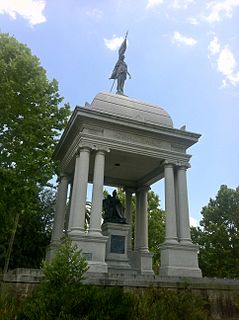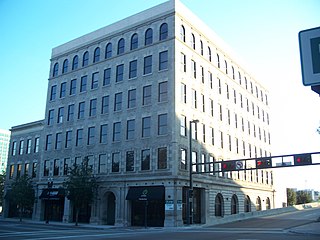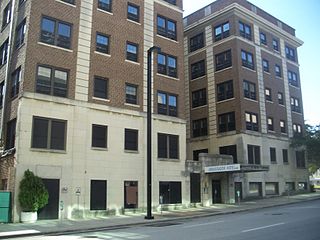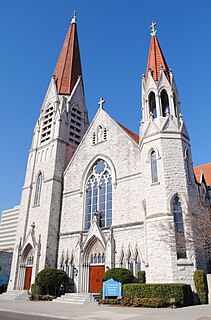
Springfield is a historic neighborhood of Jacksonville, Florida, United States, located to the north of downtown. Established in 1869, it experienced its greatest growth from the early 1880s through the 1920s. The Springfield Historic District is listed in the National Register of Historic Places, and contains some of the city's best examples of 19th and early 20th century architecture.

The Great Fire of 1901 was a conflagration that occurred in Jacksonville, Florida, on Friday, May 3, 1901. It was one of the worst disasters in Florida history and the third largest urban fire in the U.S., next to the Great Chicago Fire, and the 1906 San Francisco fire.

Ortega is a neighborhood of Jacksonville, Florida, US. It is located south of downtown Jacksonville on a peninsula off the western bank of the St. Johns River. It is one of the wealthiest neighborhoods in Jacksonville, and is the location of many historic homes and buildings.

The Dyal–Upchurch Building is a six-story, 43,747-square-foot historic building in Jacksonville, Florida. It is located at 4 East Bay Street, and was designed by architect Henry John Klutho. On April 17, 1980, it was added to the U.S. National Register of Historic Places.

The Henry John Klutho House is a historic home in Jacksonville, Florida. The house was designed and lived in by the New York City architect Henry John Klutho, who helped in the rebuilding of Jacksonville after the Great Fire of 1901. It is located at 28-30 West 9th Street. On December 19, 1978, it was added to the U.S. National Register of Historic Places.

The St. James Building is an historic building in Downtown Jacksonville, Florida, currently housing Jacksonville City Hall. It was designed by architect Henry John Klutho and opened in 1912. One of many structures in downtown Jacksonville designed by Klutho after the Great Fire of 1901, it is considered his Prairie School masterpiece.

The Morocco Temple is a historic Shriners International building in Jacksonville, Florida. It is located at 219 Newnan Street, and was designed by New York City architect Henry John Klutho. On November 29, 1979, it was added to the U.S. National Register of Historic Places. The building is the oldest Shrine temple in Florida.

The Florida Baptist Building is a historic building in Jacksonville, Florida. It is located at 218 West Church Street, and was designed by New York City architect Henry John Klutho. On January 12, 1984, it was added to the U.S. National Register of Historic Places.

Henry John Klutho (1873–1964) was an American architect known for his work in the "Prairie School" style. He helped in the reconstruction of Jacksonville, Florida after the Great Fire of 1901—the largest-ever urban fire in the Southeast—by designing many of the new buildings built after the disaster. This period lasted until the beginning of World War I. Several Jacksonville architects began their careers in the offices of Klutho's firm.

The 310 West Church Street Apartments, also known as the Ambassador Hotel, is a historic building located at 420 North Julia Street in Jacksonville, Florida, United States. On April 7, 1983, it was added to the U.S. National Register of Historic Places.

The Basilica of the Immaculate Conception is a historic Catholic church in Downtown Jacksonville, Florida, U.S. A parish church in the Diocese of St. Augustine, it represents Jacksonville's oldest Catholic congregation. The current building, dating to 1910, was added to the U.S. National Register of Historic Places in 1992 as the Church of the Immaculate Conception, and was named a minor basilica in 2013. It is located at 121 East Duval Street; its current pastor is Very Reverend Blair Gaynes.

The Mount Zion AME Church is a historic church in Jacksonville, Florida, United States. It is located at 201 East Beaver Street. On December 30, 1992, it was added to the U.S. National Register of Historic Places. The "AME" is an abbreviation of African Methodist Episcopal, the religious denomination.

The Jacksonville Public Library is the public library system of Jacksonville, Florida. It primarily serves Jacksonville and Duval County, and is also used by the neighboring Baker, Nassau, Clay, and St. Johns Counties. It is one of the largest library systems in Florida, with a collection of over three million items. A division of the city government, the library has the third largest group of city employees after the city's Fire Department and Sheriff's Office. There are twenty branches and a Main Library in the system.

The Jacksonville Fire Museum is part of the Jacksonville Fire and Rescue Department's Fire Prevention Division. The museum is home to artifacts detailing the history of the fire service not only in Jacksonville, but the entire state of Florida. Exhibits include photos from and a diorama of the Great Fire of 1901, a fully restored 1902 LaFrance horse-drawn fire engine, and a 1926 American LaFrance fire engine.

The Laura Street Trio is a group of three historic buildings located on and near Laura Street in downtown Jacksonville, Florida. The Trio consists of two perpendicularly arranged skyscrapers, the Florida Life Building and the Bisbee Building, plus a third structure, the Old Florida National Bank, which is framed by the other two in a unique pattern. The three buildings, constructed in the wake of the Great Fire of 1901, are architecturally significant, but are currently endangered.

Riverside and Avondale are two adjacent and closely associated neighborhoods, alternatively considered one continuous neighborhood, of Jacksonville, Florida. The area is primarily residential, but includes some commercial districts, including Five Points, the King Street District, and the Shoppes of Avondale.

Wilbur Bacon Camp (1860-1918) was one of a number of out-of-town architects and builders attracted to Jacksonville, FL by the construction opportunities created by the disastrous Great Fire of 1901.

Snyder Memorial Methodist Church, originally known as Trinity Methodist Episcopal Church, is a historic 1903 church in Jacksonville, Florida. It is located at 226 North Laura Street in Duval County. The Snyder Memorial Methodist congregation was founded in 1870, and the church was constructed following the loss of a previous church during the 1901 Jacksonville Fire on the same site as its predecessor. J. H. W. Hawkins was the building's architect. The new church was named Snyder Memorial in honor of former pastor E.B. Snyder whose children contributed to the rebuilding effort. It was later sold to the City of Jacksonville. It was added to the National Register of Historic Places on March 13, 2013.

The architecture of Jacksonville is a combination of historic and modern styles reflecting the city's early position as a regional center of business. According to the National Trust for Historic Preservation, there are more buildings built before 1967 in Jacksonville than any other city in Florida, but it is also important to note that few structures in the city center predate the Great Fire of 1901. Numerous buildings in the city have held state height records, dating as far back as 1902, and last holding a record in 1981.

Laura Street is a north–south street in Jacksonville, Florida, United States, named for the daughter of the city's founder, Isaiah D. Hart. Historically, the downtown portion of Laura Street has been considered the financial district of Jacksonville.






















